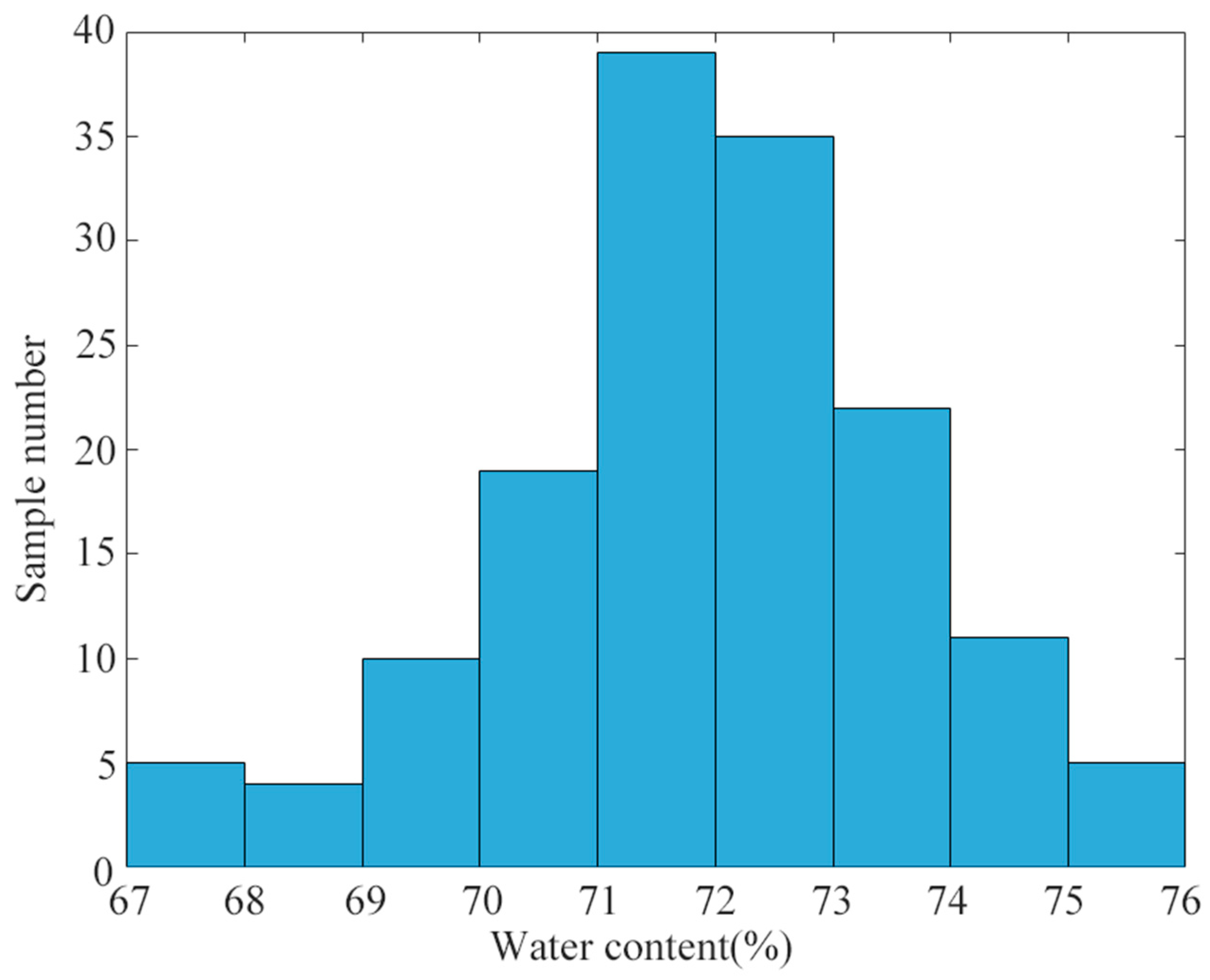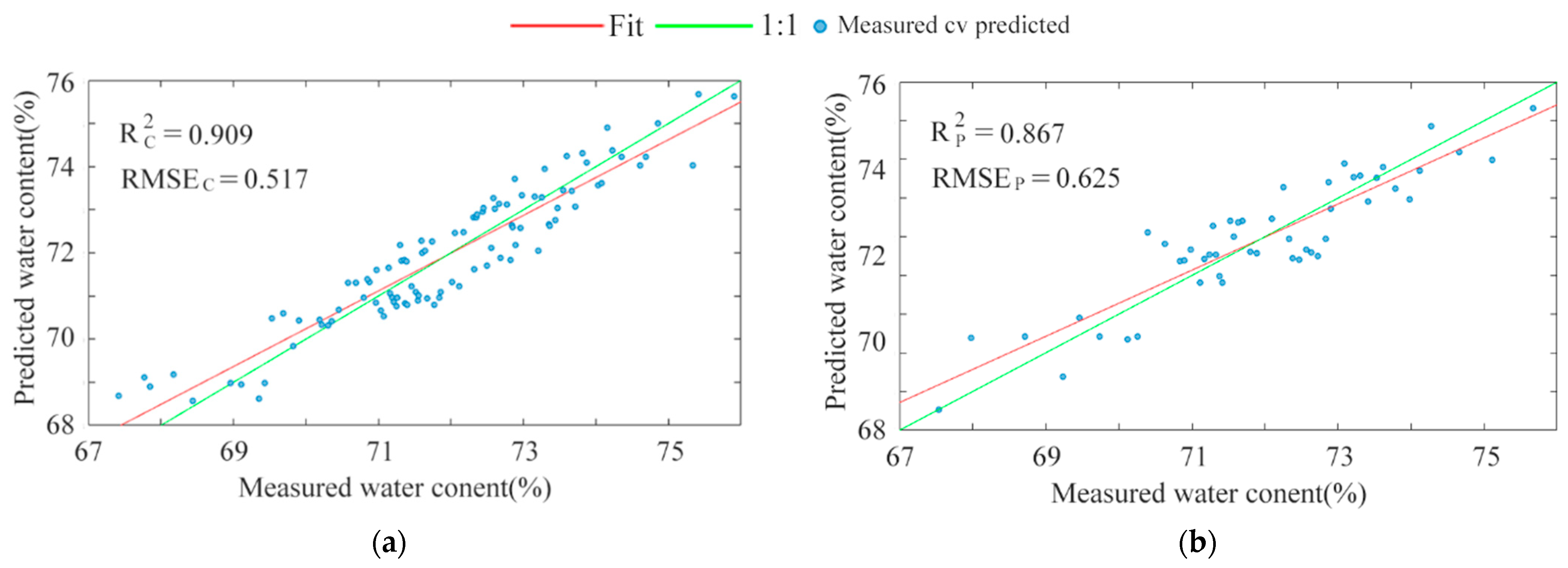Non-Destructive Detection of Water Content in Pork Based on NIR Spatially Resolved Spectroscopy
Abstract
:1. Introduction
2. Materials and Methods
2.1. Sample Preparation
2.2. SR Spectral Measurement
2.3. Measurement of Water Content
2.4. Spectral Preprocessing
2.5. Model Construction and Optimization of the LS-D Distance
2.6. Characteristic Wavelength Selection
2.7. Software
3. Results and Discussion
3.1. Statistics of Measured Water Content
3.2. Spectral Characteristics of Pork Samples
3.3. Modelling Construction and Optimization of the LS-D Distance
3.4. Characteristic Wavelength Selection
4. Conclusions
Author Contributions
Funding
Institutional Review Board Statement
Data Availability Statement
Acknowledgments
Conflicts of Interest
References
- Chernukha, I.; Kotenkova, E.; Pchelkina, V.; Ilyin, N.; Utyanov, D.; Kasimova, T.; Surzhik, A.; Fedulova, L. Pork fat and meat: A balance between consumer expectations and nutrient composition of four pig breeds. Foods 2023, 12, 690. [Google Scholar] [CrossRef]
- Xu, Y.; Zhang, D.; Xie, F.; Li, X.; Schroyen, M.; Li, C.; Hou, C. Changes in water holding capacity of chilled fresh pork in controlled freezing-point storage assisted by different modes of electrostatic field action. Meat Sci. 2023, 204, 109269. [Google Scholar] [CrossRef]
- Liu, P.; Li, J. Three methods of detecting moisture content in pork. Meat Ind. 2018, 443, 33–35. [Google Scholar]
- Prieto, N.; Pawluczyk, O.; Dugan, M.E.R.; Aalhus, J.L. A review of the principles and applications of near-infrared spectroscopy to characterize meat, fat, and meat products. Appl. Spectrosc. 2017, 71, 1403–1426. [Google Scholar] [CrossRef]
- Guo, Q.; Peng, Y.; Li, Y.; Tian, W.; Qiao, X. Design and test of optical sensor for meat non-destructive detection. Trans. Chin. Soc. Agric. Mach. 2020, 51, 484–490. [Google Scholar]
- Zhang, H.-Y.; Peng, Y.-K.; Wang, W. Rapid non-destructive detection of water content in fresh pork. J. Food Saf. Qual. 2012, 3, 23–26. [Google Scholar]
- Igne, B.; Talwar, S.; Feng, H.; Drennen, J.K.; Anderson, C.A. Near-Infrared spatially resolved spectroscopy for tablet quality determination. J. Pharm. Sci. 2015, 104, 4074–4081. [Google Scholar] [CrossRef]
- Zheng, X.; Chen, L.; Lin, X.; Zhang, D. Non-Destructive detection of meat quality based on multiple spectral dimension reduction methods by near-infrared spectroscopy. Foods 2023, 12, 300. [Google Scholar] [CrossRef]
- Mishra, P.; Verkleij, T.; Klont, R. Improved prediction of minced pork meat chemical properties with near-infrared spectroscopy by a fusion of scatter-correction techniques. Infrared Phys. Technol. 2021, 113, 103643. [Google Scholar] [CrossRef]
- Qiao, L.; Lu, B.; Dong, J.; Li, B.; Zhao, B.; Tang, X. Total volatile basic nitrogen content in duck meat of different varieties based on calibration maintenance and transfer by use of a near-infrared spectrometric model. Spectrosc. Lett. 2020, 53, 44–54. [Google Scholar] [CrossRef]
- Yuan, H.; Liu, C.; Wang, H.; Wang, L.; Dai, L. Early pregnancy diagnosis of rabbits: A non-invasive approach using NIR spatially resolved spectroscopy. Spectrochim. Acta Part A Mol. Biomol. Spectrosc. 2022, 264, 120251. [Google Scholar] [CrossRef]
- Wen, X.; Wang, Z.; Huang, L. Measurement of myoglobin in pork meat by using steady spatially-resolved spectroscopy. Trans. CSAE 2010, 26, 375–379. [Google Scholar]
- Tanaka, N.; Katoh, I.R.; Yamamoto, M.; Hoshino, K.; Morimoto, Y.; Ito, Y.M.; Kato, T. Changes in cerebral oxygen saturation during one-lung ventilation determined using spatially resolved spectroscopy and contributing factors. J. Clin. Anesth. 2020, 59, 99–100. [Google Scholar] [CrossRef]
- Bogomolov, A.; Belikova, V.; Galyanin, V.; Melenteva, A.; Meyer, H. Reference-free spectroscopic determination of fat and protein in milk in the visible and near infrared region below 1000nm using spatially resolved diffuse reflectance fiber probe. Talanta 2017, 167, 563–572. [Google Scholar] [CrossRef]
- Beers, R.V.; Aernouts, B.; Gutiérrez, L.L.; Erkinbaev, C.; Rutten, K.; Schenk, A.; Nicolaï, B.; Saeys, W. Optimal illumination-detection distance and detector size for predicting braeburn apple maturity from VIS/NIR laser reflectance measurements. Food Bioprocess Technol. 2015, 8, 2123–2126. [Google Scholar] [CrossRef]
- Zhang, L.; Sun, M.; Wang, Z.; Li, H.; Li, Y.; Li, G.; Lin, L. Noncontact blood species identification method based on spatially resolved near-infrared transmission spectroscopy. Infrared Phys. Technol. 2017, 85, 32–38. [Google Scholar] [CrossRef]
- GB5009.3-2010; Determination of Moisture in Foods. Ministry of Health of the People’s Republic of China: Beijing, China, 2010.
- Wang, M.; An, H.; Cai, W.; Shao, X. Wavelet Transform Makes Water an Outstanding Near-Infrared Spectroscopic Probe. Chemosensors 2023, 11, 37. [Google Scholar] [CrossRef]
- Rukundo, I.R.; Danao, M.-G.C.; Mitchell, R.B.; Weller, C.L. Evaluation of predictive performance of PLS regression models after being transferred from benchtop to handheld NIR spectrometers. Biosyst. Eng. 2022, 218, 245–255. [Google Scholar] [CrossRef]
- Yan, X.; Xie, Y.; Chen, J.; Yuan, T.; Leng, T.; Chen, Y.; Xie, J.; Yu, Q. NIR spectrometric approach for geographical origin identification and taste related compounds content prediction of lushan yunwu tea. Foods 2022, 11, 2976. [Google Scholar] [CrossRef]
- Li, Y.; Yang, X. Quantitative analysis of near infrared spectroscopic data based on dual-band transformation and competitive adaptive reweighted sampling. Spectrochim. Acta Part A Mol. Biomol. Spectrosc. 2023, 285, 121924. [Google Scholar] [CrossRef]
- Cozzolino, D.; Murray, I. Identification of animal meat muscles by visible and near infrared reflectance spectroscopy. LWT 2004, 37, 447–452. [Google Scholar] [CrossRef]
- Cozzolino, D.; Murray, I. Effect of sample presentation and animal muscle species on the analysis of meat by near infrared reflectance spectroscopy. J. Near Infrared Spectrosc. 2002, 10, 37–44. [Google Scholar] [CrossRef]
- Barbin, D.; Elmasry, G.; Sun, D.-W.; Allen, P. Near-infrared hyperspectral imaging for grading and classification of pork. Meat Sci. 2012, 90, 259–268. [Google Scholar] [CrossRef]
- Stuart, B. Infrared Spectroscopy: Fundamentals and Applications; Wiley: New York, NY, USA, 2004; pp. 71–94. [Google Scholar]
- Huang, Y.; Chen, G.; Xia, J.; Yu, H. Status and trends of nondestructive detection technology for water-injected meat. Trans. Chin. Soc. Agric. Mach. 2015, 46, 207–215. [Google Scholar]








| Dataset | Sample Number | Minimum | Maximum | Mean | STD |
|---|---|---|---|---|---|
| Sample set | 150 | 67.42% | 75.91% | 71.91% | 1.72% |
| Calibration set | 100 | 67.42% | 75.91% | 71.92% | 1.72% |
| Prediction set | 50 | 67.54% | 75.67% | 71.91% | 1.73% |
| Single-Point SR Spectra | LS-D Distance (mm) | nLV | R2C | RMSEC | R2P | RMSEP |
|---|---|---|---|---|---|---|
| SR1 | 4 | 7 | 0.795 | 0.775 | 0.751 | 0.855 |
| SR2 | 5 | 7 | 0.830 | 0.705 | 0.810 | 0.747 |
| SR3 | 6 | 6 | 0.814 | 0.738 | 0.804 | 0.758 |
| SR4 | 7 | 7 | 0.847 | 0.670 | 0.823 | 0.720 |
| SR5 | 8 | 7 | 0.842 | 0.681 | 0.815 | 0.737 |
| SR6 | 9 | 7 | 0.851 | 0.663 | 0.829 | 0.708 |
| SR7 | 10 | 7 | 0.855 | 0.651 | 0.831 | 0.704 |
| SR8 | 11 | 7 | 0.846 | 0.736 | 0.830 | 0.707 |
| SR9 | 12 | 7 | 0.847 | 0.667 | 0.825 | 0.717 |
| SR10 | 13 | 7 | 0.824 | 0.720 | 0.808 | 0.751 |
| SR11 | 14 | 7 | 0.807 | 0.753 | 0.797 | 0.771 |
| SR12 | 15 | 7 | 0.805 | 0.756 | 0.786 | 0.792 |
| SR13 | 16 | 7 | 0.789 | 0.785 | 0.740 | 0.873 |
| SR14 | 17 | 6 | 0.777 | 0.808 | 0.756 | 0.815 |
| SR15 | 18 | 7 | 0.779 | 0.806 | 0.723 | 0.901 |
| SR16 | 19 | 6 | 0.749 | 0.858 | 0.691 | 0.952 |
| SR17 | 20 | 6 | 0.697 | 0.942 | 0.670 | 0.983 |
| Number of SR Spectra | Optimal Combination of SR Spectra | Optimal Combination of LS-D Distance (mm) | nLV | R2C | RMSEC | R2P | RMSEP |
|---|---|---|---|---|---|---|---|
| 2 | SR7, SR8 | 10, 11 | 7 | 0.879 | 0.598 | 0.853 | 0.657 |
| 3 | SR3, SR7, SR9 | 6, 10, 12 | 8 | 0.884 | 0.585 | 0.858 | 0.645 |
| 4 | SR2, SR4, SR7, SR9 | 5, 7, 10, 12 | 8 | 0.915 | 0.501 | 0.878 | 0.598 |
| Type of Model Wavelength | Wavelength Number | nLV | R2C | RMSEC | R2P | RMSEP |
|---|---|---|---|---|---|---|
| Full wavelength (the optimal single-point SR spectra) | 1031 | 7 | 0.855 | 0.651 | 0.831 | 0.704 |
| Full wavelength (the optimal combination of SR spectra) | 4124 | 8 | 0.915 | 0.501 | 0.878 | 0.598 |
| Characteristic wavelength | 24 | 7 | 0.909 | 0.517 | 0.867 | 0.625 |
Disclaimer/Publisher’s Note: The statements, opinions and data contained in all publications are solely those of the individual author(s) and contributor(s) and not of MDPI and/or the editor(s). MDPI and/or the editor(s) disclaim responsibility for any injury to people or property resulting from any ideas, methods, instructions or products referred to in the content. |
© 2023 by the authors. Licensee MDPI, Basel, Switzerland. This article is an open access article distributed under the terms and conditions of the Creative Commons Attribution (CC BY) license (https://creativecommons.org/licenses/by/4.0/).
Share and Cite
Zhang, Z.; Wang, S.; Zhang, Y. Non-Destructive Detection of Water Content in Pork Based on NIR Spatially Resolved Spectroscopy. Agriculture 2023, 13, 2114. https://doi.org/10.3390/agriculture13112114
Zhang Z, Wang S, Zhang Y. Non-Destructive Detection of Water Content in Pork Based on NIR Spatially Resolved Spectroscopy. Agriculture. 2023; 13(11):2114. https://doi.org/10.3390/agriculture13112114
Chicago/Turabian StyleZhang, Zhiyong, Shuo Wang, and Yanqing Zhang. 2023. "Non-Destructive Detection of Water Content in Pork Based on NIR Spatially Resolved Spectroscopy" Agriculture 13, no. 11: 2114. https://doi.org/10.3390/agriculture13112114




